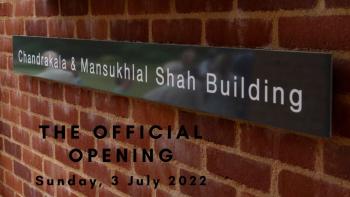The Chandrakala & Mansukhlal Shah Building: Official Opening
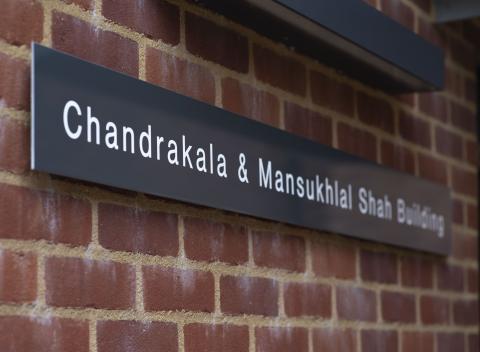
The Chandrakala & Mansukhlal Shah Building, the new home for the Robinson College Archive, was officially opened with a ribbon cutting ceremony on Sunday, 3 July 2022. Hosted by the Warden, Sir Richard Heaton KCB, and attended by many of the donors who had contributed to the building, it was a very special occasion.
In his welcome speech, Sir Richard thanked all donors for making it possible for Robinson to have this new purpose-built home for the College Archive. He expressed special thanks to Ross and Jane Reason, who initiated the building and kickstarted the fundraising campaign with a Leadership gift. Named after the parents of principal benefactors Hamel and Meredith DePaolo Shah, the ribbon was cut by Meredith and Mr Shah’s mother Mrs Chandri Shah. In his speech Mr Shah (Economics, 1994) spoke about the importance of preserving the past for future generations and of remembering the people and events that shaped our lives and the lives of the institutions that helped us form and prepare for life. He emphasised the importance of his family and the support he had received over the years from his parents to whom he dedicated his very personal benefaction.
Mr Kevin Parry OBE (Management Studies,1980) who lent his name to the Reading Room of the College Archive was also present at the ceremony. In his speech, he talked about the importance of remembering and preserving the past for present and future generations. Once the ribbon was cut and the Chandrakala & Mansukhlal Shah Building was officially opened, the assembled guests toasted this new addition to the Robinson College estate.
After the talk given by the Fellow Archivist Wing Commander Peter Milloy about the history of Robinson College Archive and its archivists , the day of celebrations finished with afternoon tea at the Crausaz Wordsworth Building. It was a very special day in the life of Robinson College and its community.
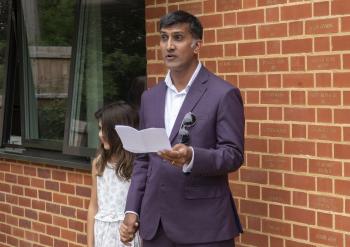
♦A speech by Hamel Shah ♦
I graduated from Cambridge in 1997.
At that time, Robinson was just twenty years old, still in its early days compared to some of the other colleges at this University founded more than 700 years ago. In fact, 25 years later, I am now a middle-aged man, but Robinson is still in its infancy.
And anyone with an infant can tell you the importance of documentation. We take photos and videos, record milestones, and make memories, because the earliest years are the ones that so often shape a future. But they are also the years that can be forgotten and reinterpreted as time marches forward.
As we approach the half-century mark, the erection of the Robinson Archival Building ensures that the history of Robinson College will be meticulously and safely retained.
Creating a permanent home for Robinson’s many records will protect the work led by Wing Commander Peter Milloy and before him Dr. Joachim Whaley, Commander George Coupe, and Dr Martin Brett. Now, the story of Robinson will be accessible to the scholars that come here for the next 700 years.
I am pleased that my wife Meredith and I were able to contribute toward the completion of this small yet mighty building. And I am proud to have the archive in the name of my mother and father. They are both immigrants to the UK from Kenya by way of India. And though I was born and raised in London, they instilled in me the importance of history.
I wonder: Can anyone here, name for me, all of their 8 great grandparents? No? It’s difficult. Our memories fade three, two, even one generation into our future. At home, my parents always reminded us of the importance of our Gujarati heritage, from the language we spoke, the food we cooked, and the songs we sang. We kept the tradition of our culture alive while also building a future in our new English home.
Now I live in Kuala Lumpur where both my daughters, Margot and Milly, were born. My family is blended by race, religion, culture, and country. As a father, a son, and a Cambridge graduate, it is gratifying to know that as the face of family, country, and this college evolve, there is now a place that will be cataloguing the ongoing story of Robinson College. It pleases me greatly to have this archive dedicated to my parents — the Chandrakala and Mansukhlal Shah Building.
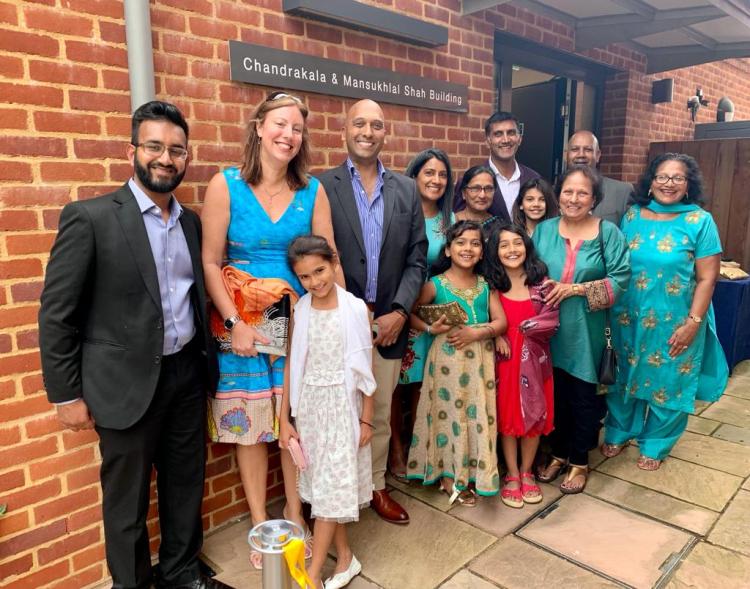
♦ A speech by Kevin Parry OBE♦
Warden, Fellows and fellow Guests
Thank you for inviting the guests here today to celebrate the official - somewhat delayed by Covid - opening of the Chandrakala & Mansukhlal Shah Building.
It’s taken 40 years to establish a permanent home for the archives. And it is timely that records are being formalised and preserved. Society appears more interested than ever in establishing historical facts and questioning and challenging historical opinions – opinions and conclusions that are sometimes hotly disputed – allowing for debate and demonstrating the freedom of expression that we are fortunate to enjoy in a democratic society.
Nowadays, research of history is not just by professional historians and journalists, but also by many amateur historians who are taking advantage of the ease of digital access to materials. Indeed, many new industries have been established over the past 20 years based on processing information into knowledge.
I recently read that approximately one in 40 people have to some extent researched their family history. Whether that statistic is reliable or not, does not matter, but it demonstrates peoples’ widespread interest in lives that went before them.
Nearly everyone who passes through the College is here for only three or so years as a graduate or post-graduate. Even most fellows have only a short tenure before they move elsewhere. A few stay longer and their accumulation of knowledge about the College and its people will be particularly important to the archivist of the day. Reading the Robinson Record and other communications from the College always reminds me that members of the non-academic staff frequently stay longer than teaching staff. We should not forget their contribution to College life. For example, as I admire the garden, it is perhaps appropriate to acknowledge it is the gardeners who make the largest contribution to the future living environment.
I hope that the growing archive will allow future generations to look back on the broad family that belongs to this college. The archives should allow people (and machines, using artificial intelligence) to learn about the formation and development of the College and its site, to understand the evolution of the academic, sporting, social and religious fabric of the College, to comprehend Robinson’s and Cambridge’s contribution to academics’ education and research, and for that matter the role the College played in developing people in other walks of life that Robinson helped to shape, and, of course, to admire Robinson’s contribution to the University and beyond
So the archive is underway for future generations to research and to enjoy. Robinson has a great opportunity to create a complete history of its existence and its people just because it is only 40 years old. Most of us – whether we played a large or small part in its evolution - are lucky enough to still be around. I hope the building’s existence will encourage people to find old documents and other media and to donate them – or loan them – to the archive. I also hope memories can be recorded before they are lost. Archivists are so fortunate today that most history can be committed to digital media -whether in two or three dimensions -making it more readily accessible than ever before on or off premises.
I am sure I speak for all the donors in hoping that current and future generations enjoy accessing and researching the archive’s current and future materials.
Thank you for making this possible.
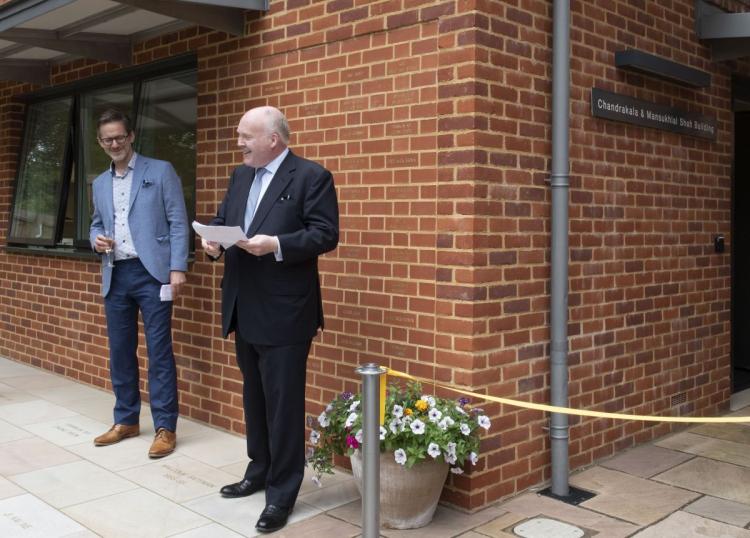
*******
The video recording of the speeches and the ribbon cutting ceremony can be watched here.
A small selection of photographs taken during the ceremony can be accessed by clicking on the image below. We hope that it will help bring back memories of that sunny summer Sunday at Robinson to those present and tell the story of the event those who were not able to attend. Please click on the image below to view.
Photography: Nic Marchant
